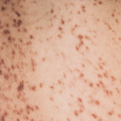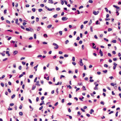Urticaria Pigmentosa
General Information
Urticaria Pigmentosa is an uncommon disease characterized by lesions that produce intense itching (pruritus). Urticaria Pigmentosa is the most common form of mastocytosis disorder, a disorder characterized by mast cell proliferation and accumulation within various organs, most commonly the skin. Lesions appear as oval or round, reddish-brown, macules, papules or plaques ranging from a couple to a thousand on the body. When a lesion is rubbed or itched, the lesion urticates becoming pruritic, edmatous, and erythematous. This change is called Darier’s sign – the mast cells release histamines, which cause the swelling, itching and redness. The most common treatment is the use of antihistamines, which help to fight the itching and flushing of the skin.
Epidemiology
0.1-0.8% has some form of mastocytosis
Etiology
Excessive numbers of inflammatory cells in the skin
Pathogenesis
Cell growth factors stimulate mast cell proliferation, melanocyte proliferation, and melanin pigment production.
Clinical
Oval or round red-brown macules, papules, or plaques ranging in number from a couple to a thousand
Histology
Sparse superficial perivascular infiltrates of mast cells around widely dilated venules of the superficial plexus, and those cells are scattered in the interstitium of the upper part of the reticular dermis.
Bibliography
1. “Mastocytosis” (Online). January 2008. http://www.emedicine.com/derm/topic258.htm (visited: April 4, 2008) 2. “Urticaria Pigmentosa” (Online). http://www.women-health-guide.com/skin-disorders/urticaria-pigmentosa.htm (visited: April 4, 2008)
Download PDF
![]() Urticaria Pigmentosa
Urticaria Pigmentosa


